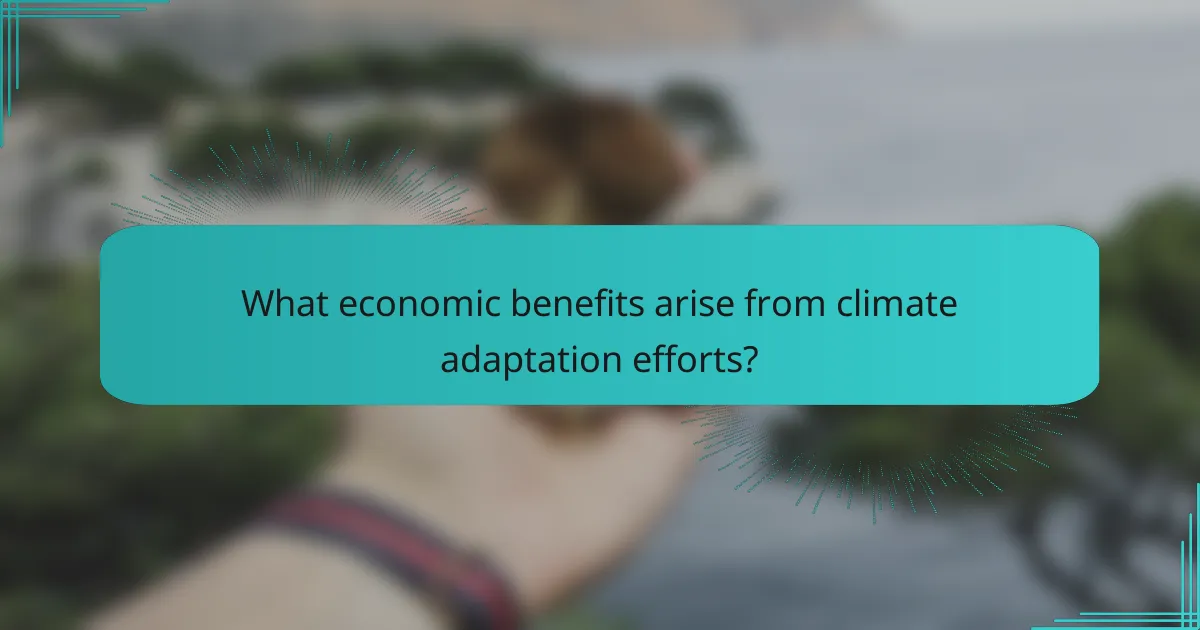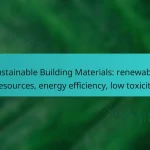Successful climate change adaptation strategies in Australia focus on enhancing resilience, engaging communities, and generating economic benefits. By addressing local vulnerabilities through collaborative initiatives, these strategies not only empower residents but also promote sustainable development and create new economic opportunities.

What are successful climate change adaptation strategies in Australia?
Successful climate change adaptation strategies in Australia focus on enhancing resilience, engaging communities, and generating economic benefits. These strategies encompass a range of initiatives that address local vulnerabilities while promoting sustainable development.
Coastal management initiatives
Coastal management initiatives in Australia aim to protect shorelines from erosion and flooding, particularly in vulnerable areas. Strategies include the construction of sea walls, restoration of mangroves, and the implementation of setback regulations for new developments.
For example, the use of natural barriers like dunes and wetlands can significantly reduce the impact of storm surges. Communities are encouraged to participate in planning processes to ensure that local knowledge and needs are integrated into these initiatives.
Urban green spaces development
Urban green spaces development focuses on creating parks, gardens, and green roofs to mitigate the urban heat island effect and improve air quality. These spaces provide essential ecosystem services and enhance community well-being.
In cities like Melbourne and Sydney, local governments have invested in expanding green areas, which can lower temperatures by several degrees during heatwaves. Engaging residents in the design and maintenance of these spaces fosters a sense of ownership and community pride.
Water resource management programs
Water resource management programs in Australia are crucial for adapting to changing rainfall patterns and increasing drought frequency. These programs often include rainwater harvesting, stormwater reuse, and efficient irrigation practices.
For instance, urban areas are implementing systems to capture and reuse stormwater, which can reduce reliance on potable water sources. Communities are encouraged to adopt water-saving technologies and practices to enhance resilience against water scarcity.
Indigenous knowledge integration
Integrating Indigenous knowledge into climate adaptation strategies leverages centuries of experience in managing land and resources sustainably. This approach recognizes the value of traditional ecological knowledge in addressing contemporary challenges.
Collaborative projects with Indigenous communities can lead to more effective land management practices, such as controlled burns to reduce bushfire risks. This integration fosters respect for cultural heritage and promotes community engagement in climate resilience efforts.
Disaster resilience planning
Disaster resilience planning involves preparing communities for extreme weather events through risk assessment, emergency response strategies, and infrastructure improvements. This proactive approach helps minimize damage and supports quicker recovery.
Local governments often conduct drills and workshops to educate residents about emergency procedures and resources. Effective planning includes clear communication channels and the establishment of community support networks to assist during crises.

How does community engagement enhance climate resilience?
Community engagement enhances climate resilience by fostering collaboration and empowering local populations to take action against climate impacts. Involving residents in decision-making processes leads to tailored solutions that address specific vulnerabilities while building a sense of ownership and responsibility.
Local workshops and training programs
Local workshops and training programs are essential for educating communities about climate risks and adaptive strategies. These sessions can cover topics like sustainable agriculture, water conservation, and disaster preparedness, equipping participants with practical skills. For example, a workshop on rainwater harvesting can help residents manage water scarcity effectively.
To maximize participation, consider scheduling workshops at convenient times and locations, and promote them through local networks. Engaging local leaders as facilitators can also enhance credibility and encourage attendance.
Partnerships with NGOs
Partnerships with non-governmental organizations (NGOs) can significantly bolster community engagement in climate resilience efforts. NGOs often bring expertise, resources, and funding that local communities may lack. Collaborating with these organizations can facilitate the implementation of projects such as reforestation or renewable energy initiatives.
When forming partnerships, it’s crucial to align goals and ensure that the community’s needs are prioritized. Regular communication and feedback loops can help maintain transparency and trust between the community and the NGO.
Citizen science projects
Citizen science projects involve community members in data collection and monitoring, enhancing local understanding of climate issues. These initiatives can range from tracking local wildlife populations to measuring air quality, providing valuable insights for climate adaptation strategies. For instance, residents can use mobile apps to report flooding incidents, helping authorities respond more effectively.
To encourage participation, provide training on data collection methods and ensure that findings are shared with the community. Recognizing contributors through events or certificates can also motivate ongoing involvement and foster a culture of scientific inquiry.

What economic benefits arise from climate adaptation efforts?
Climate adaptation efforts yield significant economic benefits by fostering resilience, enhancing community engagement, and creating new opportunities. These benefits include job creation in green sectors, increased property values, and cost savings from disaster prevention measures.
Job creation in green sectors
Investments in climate adaptation often lead to job creation in renewable energy, sustainable agriculture, and eco-friendly construction. For instance, transitioning to solar or wind energy can generate thousands of jobs in installation and maintenance, particularly in regions focused on reducing carbon footprints.
Moreover, local governments and organizations can stimulate employment by promoting green infrastructure projects, such as urban tree planting or flood management systems. These initiatives not only create jobs but also enhance community resilience against climate impacts.
Increased property values
Properties in areas that have implemented effective climate adaptation strategies tend to see increased values. For example, homes located in neighborhoods with robust flood defenses or improved green spaces often attract higher prices due to their reduced risk of climate-related damage.
Additionally, areas that prioritize sustainable development and climate resilience can become more desirable for buyers, leading to a positive feedback loop where improved infrastructure boosts local economies and further elevates property values.
Cost savings from disaster prevention
Investing in climate adaptation can lead to substantial cost savings by minimizing the financial impact of disasters. For example, spending on early warning systems and resilient infrastructure can save communities millions in recovery costs after extreme weather events.
Furthermore, proactive measures such as enhancing drainage systems or reinforcing coastal barriers can reduce insurance premiums and lower the economic burden on local governments and taxpayers. This preventative approach not only protects lives but also preserves local economies from the shocks of climate change.

What frameworks support climate adaptation in Australia?
Australia employs various frameworks to enhance climate adaptation, focusing on resilience, community involvement, and economic benefits. These frameworks guide local and national efforts to address climate impacts through structured strategies and plans.
National Climate Resilience and Adaptation Strategy
The National Climate Resilience and Adaptation Strategy provides a comprehensive approach to managing climate risks across Australia. It emphasizes the need for collaboration between governments, businesses, and communities to build resilience against climate change impacts.
This strategy outlines key actions, such as improving climate data accessibility and integrating climate considerations into planning and decision-making processes. It encourages stakeholders to adopt adaptive practices that can mitigate risks and capitalize on opportunities arising from climate change.
State-level adaptation plans
Each Australian state has developed its own adaptation plans tailored to local climate risks and community needs. These plans detail specific actions and initiatives aimed at enhancing resilience in vulnerable regions.
For example, New South Wales focuses on coastal management and water resource planning, while Queensland emphasizes disaster preparedness and recovery. These state-level plans often include community engagement strategies to ensure local voices are heard and incorporated into adaptation efforts.

What role do technology and innovation play in adaptation?
Technology and innovation are crucial for enhancing climate change adaptation by providing tools and solutions that improve resilience, facilitate community engagement, and generate economic benefits. They enable efficient resource management, data collection, and decision-making processes that empower communities to respond effectively to climate challenges.
Smart city technologies
Smart city technologies integrate digital solutions to enhance urban infrastructure and services, making cities more resilient to climate impacts. These technologies include sensors, data analytics, and IoT devices that monitor environmental conditions and optimize resource use.
For example, smart water management systems can detect leaks and monitor water quality in real-time, reducing waste and ensuring safe drinking water. Similarly, smart energy grids can balance supply and demand, integrating renewable energy sources to reduce reliance on fossil fuels.
When implementing smart city technologies, cities should consider factors such as data privacy, interoperability of systems, and community involvement in decision-making. Engaging residents in the planning process can lead to more effective solutions that address local needs and enhance overall resilience.


